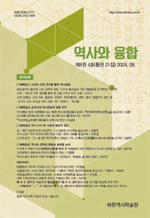본 논문은 18-19세기 여항인의 시사(詩社)와 시사도(詩社圖)를 통해 본 보름달에 대한 인식을 조명하고 세시풍속(歲時風俗)과 관련성을 연구하고자 하는데 목적이 있다. 조선시대 회화에 나타난 보름달은 사람이 관망하는 존재이자, 관념적인 자연 물상이지만 18-19세기 여항시사도에서의 보름달은 향유(享有)의 대상이었다. 여항 시사의 동인들은 달을 관념적이고 신성스러운대상이 아닌 향유의 일부로 인식하였다. 본 연구는 보름달에 대한 인식의 변화를 그림을 통해 살펴보고 김창흡의 천기론(天機論)적 자연관과 홍대용과 북학파의 인물균론(人物均論) · 인물성동론(人物性同論)적 자연관의 변화, 성령론(性靈論)으로 설명하고자 한다. 여항인의 일상을 기록한 전기류(傳記類)와시선집(詩選集)의 출판 등으로 그들의 자의식은 고양되었다. 여항인 조수삼의 「세시기(歲時記)」와 유득공의 『경도잡지(京都雜誌)』, 유본예의 『한경지략(漢京識略)』 등의 세시풍속 관련 서적 등의 저술을 통해 여항인의풍속에 대한관심을 알 수 있다. 조선후기 여항시사도를 통한 자연관의 변화, 풍류적 성령론 등은 개인적 정서의 표출로 나타난다. 이러한 경향은 시문학과 민화, 판소리 등의 대중적 문화의 저변확대를 가져오고 조선후기 문예부흥으로 이어진다. 이는 기층민에게 전파되어 자의식과 민중의식을 형성하고 문화적 근대화로 연결된 것이다.
The purpose of this study is to discuss commoners’ perceptions of the Full Moon featured in their poems and poetic paintings and examine the relationships between their perceptions and the seasonal customs during the 18th and 19th centuries. The Full Moon featured on the paintings during Joseon Dynasty was the object of people’s observation and at the same time, was a conceptual natural phenomenon, but in Yeohangsisado during 18th and 19th centuries, it was an object of savoring, neither a conceptual nor a holy object. This study reviews the peoples’ perceptional changes of the Full Moon through the paintings, and thereupon, discusses people’s perceptions of the Full Moon from the diverse perspectives: Kim Chang Heup’s cosmological view of the nature, Hong Dae Yong’s and Northerners’ theory of equal importance of characters, theory of character equivalence and doctrine of the holy spirit. Through the publications of the various biographies and the collections of essays recording commoners’ ordinary life, their self-awareness would be enhanced. Commoners’ concern with the customs would well be depicted by such books featuring the customs as Jo Su Sam’s ‘Se Si Gi’, Yoo Deuk Gong’s ‘Gyeongdojapji’, Yoo Bon Ye’s ‘Hangyeongjiryak’, etc. The changes of the view of nature and aesthetic theology of the Holy Spirit featured in Yeohangsisado during late Joseon Dynasty would be facilitated as expressions of individual emotions. Such a tendency facilitated the expansion of the base of such popular cultures as poems, folklore paintings and Pansori, ushering in the literary and art Renaissance during late Joseon Dynasty. After all, such literary and art Renaissance would lead to the enhancement of self-awareness and popular consciousness, facilitating the cultural modernization.
1. 머리말
2. 여항시사의 변천과 구성원 직업별 분류
3. 자연관의 변화와 성령론적 풍류관
4. 여항시사도에 나타난 보름달에 대한 인식과 문화양상
5. 맺음말
